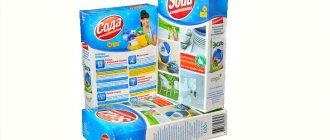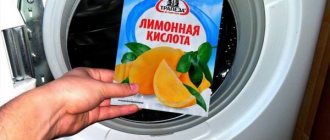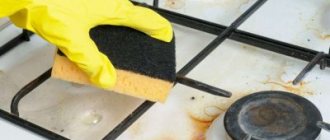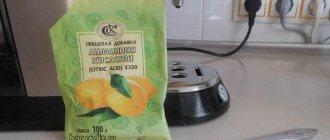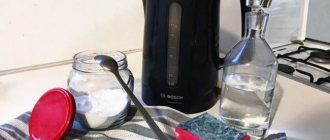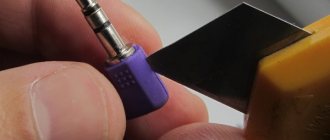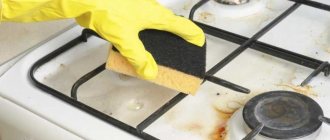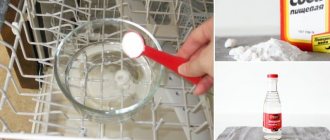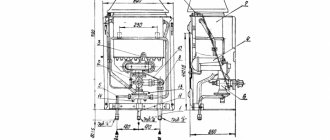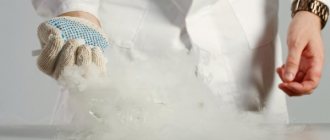One of the latest innovations among household products - a thermopot - certainly made a splash when it appeared on the market and eased the everyday worries of many housewives. But, like any other electrical appliance that comes into contact with water, it requires regular cleaning to remove limescale deposits that appear over time. How to clean a thermopot from scale at home? We have selected the most popular methods and popular tips with which you can easily cope with this trouble.
How to clean a thermopot from scale at home quickly and effectively - top 20 products
Having even a brand new device in use, you can observe how, after some time, white stains appear on its walls. This means that it’s time to clean the thermopot from scale. How and by what means can this be done at home?
Folk remedies
There are quite a few simple and effective ways to clean the device using folk remedies. Using the methods suggested below, you will effectively and completely safely remove all types of contaminants.
Vinegar
You can clean the thermopot from heavy scale using table vinegar. This is an effective remedy in combating limescale, in addition, acetic acid can cope with any, even the oldest deposits that may remain on the heating elements. To do this, mix the solution in a ratio of 2 liters of water to 100 milliliters of vinegar, pour it into the device and boil. Leave to cool completely and then rinse the device thoroughly.
Soda
A small deposit that has formed on the surface of the thermopot can be cleaned with soda. Dilute 2 dessert spoons of the product in 2 liters of water, pour the resulting solution into the container of the device and boil. After waiting for complete cooling, drain and thoroughly rinse the inner flask of all residues.
Lemon acid
If the plaque has acquired a dense sediment, you can clean the thermostat with citric acid. Since this is a fairly popular remedy, getting rid of scale will not be difficult. Add a tablespoon of crystalline substance to 1 liter of water and bring to a boil, drain the solution, removing the residue with a sponge. Rinse the container with clean water.
Soda + Citric acid
It works well to clean the thermopot with baking soda and citric acid. Fill the device with water and boil it, add 1 tablespoon of soda to the boiling water. After letting it brew, drain and boil again with a solution of citric acid. Using this method, you will get rid of not only scale, but also all foreign odors.
Soda
You shouldn't be surprised, but the drinks contain phosphoric acid, which will help remove lime deposits. Pour liquid into the flask of the device, and then bring to a boil. After the soda has cooled, drain it and rinse the device.
Apple peel
Apple peel will help remove scale from a thermopot at home; thanks to the fruit acids it contains, all contaminants are perfectly broken down. To process, pour the required amount of water, add the peel and boil. Once cooled, remove everything and rinse.
In this way, only small deposits can be washed off, so apple peelings are best used as preventive measures.
Ascorbic acid
Vitamin C, as it turns out, helps not only strengthen our body, but also perfectly cleanses scale. But keep in mind that its use is effective for minor stains and regular cleaning. To do this, dissolve 1 tablet of the drug in 1 liter of water, bring to a boil and leave for 30 minutes. Pour out all the contents and rinse thoroughly with water.
Salt
There are still quite a few ways to help us decide how to get rid of scale in a thermopot, and one of these ways is to use salt for these purposes. To clean the unit, pour 1 glass of water into the vessel, add another glass of finely crushed ice and 4 teaspoons of table salt. Stir the resulting mixture, and then walk along the walls with a sponge, removing dirt.
Coca Cola
It turned out that this drink perfectly removes plaque. How to clean a thermopot with Coca-Cola from scale? Simply pour it into the device, bring it to a boil, and then wash the flask thoroughly. When processing, do not close the lid under any circumstances, otherwise the carbonation may escape.
Cucumber pickle
Since cucumber marinade contains a small amount of acetic acid, some housewives have gotten used to using it to clean the unit. Pour brine into a container, boil and let sit for 30 minutes. Then rinse with running water to remove odor and dirt.
Potato peelings
The tubers contain ascorbic acid, although its percentage is not large, but as it turns out, it is sufficient to successfully use the peel to remove scale. To do this, you need to rinse it thoroughly and load it into the device’s container, add water and boil. As the solution cools, it will soften lime deposits.
Oat decoction
Perhaps one of the most ancient methods, which has come down to us since ancient times: pour 300-400 grams of cleanly washed grain with water and cook for an hour. Pour the strained liquid into a thermopot and set the boiling mode. After 1 hour, turn off the device and let the broth cool.
Tea mushroom
Another budget-friendly method for removing scale from a thermopot is to use vinegar, which produces kombucha. Pour the strong infusion into the flask and leave for 40 minutes, boil, and then wait for it to cool completely.
Citramon
The drug will help you get rid of plaque that is just beginning to form; it is also good as a preventative measure. Its dosage is calculated based on the volume of thermopot. On average, for a container of 3 liters, you need to prepare 2 packages of tablets, crush them into powder and add to the device, mixing with water. After boiling, drain and rinse the now cooled liquid.
succinic acid
In the same way, you can clean the thermopot from scale, taking the place of citramone, an amino acid that is widely sold in the pharmacy chain. This is an excellent tool for treating the device at home.
Household chemicals
If traditional methods do not work for you, you can try professional remedies, fortunately there are plenty of them in any store today.
Denk mit Entkaker
The formulation of this drug includes citric acid, the concentration of which allows you to remove even the most stubborn deposits without causing harm to the parts of the thermopot. Measure out 40-50 ml. Denk and add to 0.5 liters of water, boil the solution in the device. After cooling, wash with a sponge.
Top House Cleaner
Allows you to clean any type of dirt. Fill the flask of the unit with water up to the vertical mark, add 150 ml. substances and bring to a boil. Drain the cooled liquid and rinse.
Products TM Green Clean Professional
Perhaps one of the best series of cleaning products on our market will perfectly allow you to descale the thermopot at home, as well as disinfect it. Instructions for use are printed on the surface of each bottle.
Caustic or soda ash
But these substances require careful handling; they should be poured into containers with caution. Take 1 liter. water 3 tbsp. l. crystals, pour the solution into the flask, set the boiling mode, after heat treatment, let the liquid cool.
Formic acid
Formic acid can hardly be called harmless; its vapors are toxic and can cause burns. Therefore, if you still decide to use it, put on gloves and open the window in your apartment. For treatment, take the substance in a 1:1 ratio with water.
How to clean a thermopot at home
- Thermal pots and electric kettles are often cleaned with citric acid. In this case, it is not necessary to boil the water. Citric acid is more effective than baking soda, but less effective than vinegar. But at the same time it does not have such an unpleasant odor. Pour a sachet of citric acid per liter of water into a kettle of water. Leave the composition for several hours and drain the water, then rinse the thermopot;
- Instead of citric acid, you can use regular lemon, but this is a less effective method, so the procedure will have to be repeated several times. To clean, pour water into the kettle, cut pieces of lemon and throw them inside. Boil, drain the water and repeat the procedure if necessary;
- Baking soda removes scale, but not the first time. Therefore, this procedure will have to be repeated. To clean, pour water into the thermopot and add baking soda at the rate of one tablespoon per liter of water. The solution is boiled and left until it cools completely. Then the water is drained, if necessary, the cleaning process is repeated, the soda composition is drained and the kettle is washed;
- To remove scale, acetic acid 9% is often used. To clean, pour water into the kettle and add two tablespoons of acid per liter. Boil water and leave the solution for several hours. After this, replace the water with fresh water and boil the thermopot again. However, vinegar can leave an unpleasant specific odor, so you will have to boil the kettle several times;
- To remove complex scale and dirt, use a combined method. To do this, pour water into the kettle and add a tablespoon of soda per liter. Boil the thermopot for 30 minutes, replace the water with fresh water. Add a packet of citric acid and boil again for half an hour. Change the water and add half a tablespoon of acetic acid. The kettle is boiled again for half an hour. The last solution is drained and washed thoroughly;
- An unusual option to get rid of scale is to use carbonated drinks. To do this, take Sprite, Coca-Cola, Fanta or Pepsi. Pour the selected drink into the device and boil. It has been proven that such drinks effectively remove sediment and scale. It is better to choose Sprite or Sevenup, as they are colorless. Coca-Cola, Fanta and Pepsi may leave dark or bright paint marks on the interior walls;
- Another unusual method is to use potato peelings. Rinse the potato peels thoroughly and put them in the device, fill them with water, but do not boil them, but leave them for 6-8 hours. Soaked scale is washed off with a sponge and water;
- Instead of potato peels, you can use apple and/or pear peelings. Elements in the composition of fruit peel effectively cope with scale, darkening and stains, while being gentle and safe. They will return the device to its original color! Rinse the peel thoroughly in running water, place in a kettle and fill with fresh water. Boil the thermopot, drain the water and repeat the procedure. Then rinse the thermopot;
- Another popular method is to use cucumber or tomato brine. It contains citric acid, so it can remove scale. Pour the brine into a thermopot and boil. Wait until it cools down and drain and rinse the kettle. By the way, brine effectively removes rust;
- Buy special descaling products in the department or household chemicals store. To wash the thermal sweat in this way, fill the container with water and add or pour in the cleaning agent. Boil water and leave for a certain time, which is indicated in the instructions for the drug. During this period, the scale will dissolve and you can drain the water and wash the kettle.
How to prevent scale formation in a thermopot?
No matter how hard you try, you will not be able to avoid scale formation, but there are several recommendations that will help to significantly reduce the rate of its formation and extend the life of your appliance;
- Try to use filtered or bottled water;
- Clean the surface regularly;
- When removing plaque, do not scratch the inner surface of the flask;
- Change the water as often as possible.
After reading our article on how to descale a thermopot at home, you will certainly choose the most convenient option and preserve your unit for a long time.
Please rate how useful this article was to you! (No ratings yet)
Yandex recommends - the best articles on the site
You may also be interested in
- Top 20 products to descale the inside of your iron...
- Instructions: how to descale a kettle with soda?
- Instructions: how to descale a kettle with vinegar?
- Instructions: how to descale a kettle with citric acid?
- How a thermopot works: operating principle and instructions...
- Top 20 products to remove burnt marks from your iron...
- 12 simple tips on how to choose the right thermostat...
- Step-by-step instructions: how to properly clean...
- Step-by-step instructions: how to properly clean...
- Instructions: how to clean the powder tray in…
- What is better: a thermopot or a kettle? Compare by parameters
- Instructions: how to remove the smell of rotten meat, mold and...
Cleaning electrical appliances with concentrated products
In addition to advertised store-bought products, some concentrates, which every housewife almost always has on hand, will help descale the thermopot. Let's take a closer look at this group of cleansers.
Baking soda and citric acid
To properly clean the thermopot from scale with citric acid and baking soda, you will need to consistently perform the following steps:
- fill the electrical appliance with clean water;
- add twenty to thirty grams of baking soda;
- boil the resulting solution, then pour it into the sink;
- do the same steps, replacing soda with lemon.
After carrying out hygienic measures, you can easily wash off the scale in the thermopot with a regular soft sponge.
If there is no citric acid in the kitchen, you can use fresh lemons. In such a case, before sending it to the thermopot, two or three whole fruits will need to be thoroughly rinsed with clean water and cut, straight with the peel. Lemons are not only as effective as a dietary supplement, they are much safer. Therefore, they can be used to clean water heating devices even in families with allergies.
Effective ways to clean rust from a kettle
The most inexpensive, popular and effective ways to get rid of rust are still traditional methods. They are not only effective, but are always at hand and are absolutely safe for human health and utensils:
1. Citric acid is the most effective method in combating rust formation. Pour one or two bags of citric acid (depending on the degree of contamination of the device) into the kettle and fill with water almost to the top. Bring the resulting solution to a boil, boil for 10–20 minutes, drain, and rinse the container with clean water. A packet of acid can be replaced with freshly squeezed juice of one lemon.
2. Vinegar - this cleaning method is not inferior in effectiveness to citric acid. Apple cider vinegar and 6–9% table vinegar are suitable. Pour water 3/4 full into the utensils with rust stains and boil. Add the remaining 1/4 with vinegar and leave the device for 7–9 hours. Drain the solution and rinse the kettle well. If vinegar is not available, you can use vinegar essence at the rate of 3 teaspoons per liter of water. To enhance the effect, add a little salt.
3. Soda – pour half the volume of water into an enamel kettle, add 2 teaspoons of soda, boil, and simmer for 20–40 minutes. Drain the liquid and rinse the utensils thoroughly. If the appliance is electric, then after boiling, leave the water in it until it cools completely.
4. Carbonated water - the popular Coca-Cola, Fanta, Sprite or Pepsi-Cola are ideal for this purpose. In the evening, water should be poured into a bowl and left overnight. In the morning, drain the soda, thoroughly wash the utensils with a hard sponge, and rinse thoroughly with clean water.
5. Brine - from pickled tomatoes or cucumbers. Pour into a container to the top, boil, leave until cool. Drain the liquid and rinse the kettle thoroughly until the characteristic smell of brine is completely eliminated. This cleaning method is applicable to metal utensils.
6. Sour milk or kefir is a popular method among housewives. Pour 1/3 of the curdled milk into the utensils, boil, and leave in the kettle until it cools completely. Drain and rinse thoroughly with water.
7. Vegetable and fruit peelings – ideal for potatoes, pears, and apples. Wash the peelings, put them in a container, add water, bring to a boil, and leave for 3–6 hours. Drain the cleaning liquid, wash the dishes, add a portion of clean water, boil, then drain and rinse.
You can clean the kettle using special kitchen chemicals, sold in a large variety in household chemical stores. Each of them comes with detailed instructions for use, so removing rust from utensils in this way will not be difficult.
In extreme cases, regular washing powder is suitable for removing plaque. It should be poured onto existing traces of rust, moistened a little, and left for 20 minutes. After this, rub off the stains using half a raw potato.
ATTENTION! After cleaning a kitchen appliance using household chemicals, it should be rinsed very thoroughly. Boil water in a kettle and then drain it at least three times. Do not use water for preparing drinks or food until all detergent residues have been removed.
How to clean a thermopot from scale
To prevent the occurrence of undesirable consequences, it is recommended to promptly remove the resulting limescale deposits. You can get rid of scale in a thermopot using various means. Traditional methods are safe for health.
How to descale a thermopot with citric acid
Simple solutions can remove limescale deposits. Many housewives recommend descaling the thermopot with citric acid. The powder is added to the water while boiling and left in the tank until it cools. After the procedure, the tank is thoroughly rinsed with water.
To clean an electrical appliance from lime deposits, you need to use 1-2 packets of citric acid.
How to clean a thermopot from scale with vinegar
The essence allows you to effectively remove limescale. To descale a thermopot with vinegar, you need to boil water with the addition of 2 tablespoons of essence. After the procedure, a pronounced odor may remain. To eliminate it in an electrical appliance, bring water to a boil several times.
You can prevent the appearance of an unpleasant odor after cleaning a household appliance with vinegar by leaving it open.
Soda
Descaling can be done with either citric acid or carbonated drinks. Cola or mineral water can remove plaque. The drink is poured into the tank and the device is turned on. After the liquid boils, it is drained and the tank is thoroughly rinsed.
Carbonated drinks are used to clean electrical appliances from lime deposits.
Soda
Sodium bicarbonate is a popular descaling agent in thermopots. Warm water is poured into the reservoir, soda is added (1 tablespoon per liter of liquid). The device is then turned on to boil the solution. It is left in the tank until it cools. After which the liquid is poured out and the walls are cleaned with a soft sponge.
We recommend reading: Baking soda: beneficial properties, uses, how to take
Using soda does not always completely remove deposits
Brine
Marinade is an unusual way to clean household electrical appliances. You can use the brine left over from canned cucumbers or tomatoes. Before use, you must strain the liquid. The product is poured into the tank and boiled several times to clean the thermopot from heavy scale.
After using the brine, rinse the tank thoroughly with water.
Salt
You can remove scale from the thermopot using salt. This is a gentle way to clean deposits. For 1 liter of water you should take a tablespoon of salt. The liquid is poured into the tank and brought to a boil. Use a soft sponge to clean the walls after the composition has cooled.
Salt effectively removes limescale deposits
Apple peel
The method is suitable for cleaning minor deposits. The peel is cut off from several fruits, placed in a tank and filled with water. The liquid should be boiled several times to remove scale from the thermopot.
The plaque, softened after using apple peels, is washed off with a sponge.
Raw potatoes
You can wash the thermopot from scale using the peel. Fresh potato peelings should be thoroughly washed, placed in a container, and then filled with water. The liquid should be boiled and left in the tank for several hours. When the deposits soften, they can be washed off with a sponge.
We recommend reading: Potatoes: beneficial properties and contraindications
The potato cleaning procedure ends by rinsing the tank with water.
Ascorbic acid
The powder can be used to clean limescale from electrical appliances. Take a tablespoon of ascorbic acid in powder form per liter of water. The use of tablets requires their preliminary crushing. The liquid should be brought to a boil in a thermopot and poured out after it has cooled.
Ascorbic acid helps dissolve limescale formations
How to prevent scale formation
It will not be possible to completely avoid scale formation, but the rate of its occurrence can be significantly reduced if:
- Clean the thermostat at least once every 2 months.
- Always empty any remaining water from the container.
- Always rinse the device before adding water again.
- Use filtered water instead of tap water.
- Periodically inspect the walls of the thermopot under a bright lamp and, if necessary, remove scale immediately after it appears.
Thus, you can remove plaque from a thermopot using the same methods as in the case of a kettle. However, you need to monitor this device especially carefully. The volume of the thermopot is significantly larger, so it needs to be cleaned more often.
